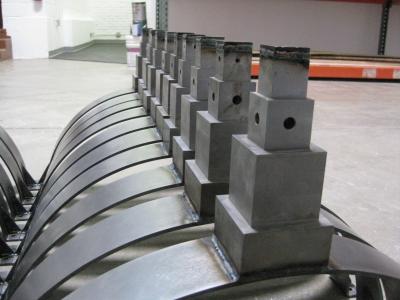FAI Patents Vibration Measurement Pipe Clamps

FAUSKE & ASSOCIATES, LLC Invention: “PIPE CLAMPS FOR VIBRATION MEASUREMENT” RECEIVES PATENT PROTECTION
Increased Data Reliability Minimizes Revenue Loss, Reduces Downtime and Produces More Precise Safety Readings
Burr Ridge, IL-
Fauske & Associates, LLC, (FAI) the world leader in nuclear, industrial and chemical process safety has obtained patent protection for its recent invention: “Pipe Clamps for Vibration Measurement.”
In power plants, it is important to monitor pipe vibration at all times as excessive pipe vibrations can ultimately lead to failure of the structure and result in an accident (e.g. high energy line break). The preferred methodology to accurately monitor vibration levels is to install sensors (accelerometers) directly on the pipeline. However, in practice this is often not feasible because of high temperature and / or radiation levels that could damage the equipment. With this new innovation, FAI has developed a solution to make the process of monitoring pipe vibration levels easier.
The specialized FAI pipe clamp can be used to seat vibration sensing equipment. A beam attached to the clamp protrudes through the pipe insulation. The beam is partially hollow and vented to promote cooling so that accelerometers can be installed on the tip of the beam outside the high temperature and / or radiation for accurate vibration level monitoring.
The dynamics of the pipe clamp have been defined by a deterministic approach as well as an experimental approach. The experimental data provides additional confidence and refinement of the theoretical analysis. It is important that the dynamic character of the clamp is fully defined as this data must be known to correctly interpret the measurement data from the accelerometers.
The FAI pipe clamp has a natural frequency of about 1 kHz. All pipe vibrations below this frequency will be accurately recorded or slightly amplified (erring on the side of conservatism) at frequencies closer to 1 kHz. This represents a major improvement compared to existing vibration measuring techniques.
According to FAI, “The invention allows us to monitor pipe vibrations more accurately in situations where transducers cannot be mounted directly to the pipe. Specifically, the design removes over conservatism when monitoring pipe vibration so the real vibration is monitored rather than an amplified value.”
Previously, plant owners commonly installed accelerometers on pipe supports or other pipe attachments with unknown dynamics. In a case of a resonance, the pipe vibration levels were heavily amplified (unrealistic and overly conservative), potentially forcing reduced power or an automatic shut down of the power plant, as demonstrated by a FAI customer that recently had to operate for several months at reduced power because of bad sensor placement and resonance of the attachment.
The newly developed FAI pipe clamps cannot establish a resonance below 1 kHz, hence, providing reliable data. The frequency of 1 kHz is sufficiently large and above expected pipe vibration frequencies which are typically in the range of 10 to 500 Hz. FAI adds that the provision of more reliable data can “help plants minimize revenue loss, reduce downtime and produce more precise safety readings.”
Founded in 1980 by Hans Fauske (D.Sc.), Michael Grolmes (PhD) and Dr. Robert Henry (PhD), FAI became a wholly owned, independently operated affiliate of Westinghouse Electric Co. in 1986. FAI assumed early leadership roles in the acclaimed DIERS program for AIChE and the IDCOR program for the nuclear power industries. These activities led to state-of-the-art methodology and laboratory tools for characterizing chemical systems and computer models for analyzing severe accidents in commercial nuclear power plants used worldwide. Recognized worldwide for phenomenological modeling related to the prevention and accommodation of chemical and nuclear power accidents, FAI also provides advanced training and research in physics, chemical engineering, mechanical engineering, nuclear engineering, computer science and other fields. FAI is ISO- 17025 / IEC, ISO-9001, TickIT certified and maintains a 10CFR50 Appendix B Program.
FAI is also recognized for conducting comprehensive plant evaluations. FAI’s Nuclear Systems Group helps its customers enhance the availability and reliability of their operating plants while maintaining regulatory compliance, extending plant life and reducing operation and maintenance costs.
